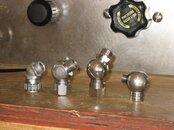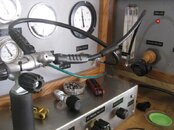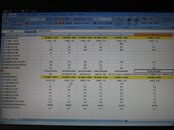Well, okay, found the announcment about the corrupted data here on this thread at the 21.12
Just in case somebody did not read my post in this time, here another chance.........
I don’t remember well anymore when the swivels came on the market in the nineties, but I remember that I was getting me one in the moment I heard about it.
I was working in East Africa where we had sometimes strenuous conditions, waves and currents , and I always felt a bit vulnerable when customers got stress, so I changed my regulator configuration and got a longer hose under my arm with a swivel.
At this time there was already a discussion about benefits and flaws of swivels. Some manufacturers claimed that it was even dangerous to use those swivels (at least the 360’swivels). I read this in a German Dive Magazin, but don’t remember which manufacturer was quoted.
I used one of the 120’ elbow swivels, but when the 360’ swivel came up I tried them on my octopus and found it even more valuable than the one for my primary 2
nd stage.
Even in turbulent diving condition it was virtually impossible to come in a situation where because of a change in position between donor and receiver the octopus could get bended out of the mouth because the octopus with the 360’ swivel would go in any necessary position.
Since 1995 I think I have been working with this regulator configuration, and even today not working as a full time instructor anymore, I would not change it.
Around 70 of my dives I did at 200’to 330’feet, I never had a problem with those swivels. I could not tell from my feeling while diving if this configuration might create a significant degradation of the performance of the 2
nd stage, because I was only diving like this, but this claim simply didn’t feel right to me. If there was a degradation in performance, it must be a minor one.
I don’t know how SP was testing which swivel, but since years I’m diving with a SP 120’ swivel.
Maybe their swivels are much safer than those of their competitors -
J.
I would be interested if ever any diver had a bad experience with using any kind of swivel.
Anyway, with this topic coming up on this forum I did some tests with my flow module to see if there was any difference in performance while testing first and second stages flow test conditions.
I used a SP MK25 with a S600 2
nd and a MKII with a R295.
I tested six different configurations:
1. No swivel
2. SP 120’swivel
3. The 120’swivel I started with about 17 years ago
4. 360’swivel in worst case position ( extreme elbow)
5. 90’swivel at the first stage
6. 90’swivel at 1
st stage plus 360’ swivel in worst case position ( extreme elbow)


The test would be done and noted at 5 SCFM, 7.5 SCFM, 10 SCFM, 12.5 SCFM and 15 SCFM which put quite some strain on all regulator parts of the 1
st and the 2
nd stage while on flow.
Any problems of air flow because of restriction whatsoever in the regulator system should be seen by changes in cracking effort under flow (CE) or differences in the dynamic intermediate pressure ( Dyn. IP) or in changes of the performance of the Venturi Assist.
I guess there are anyway only few interested how these flow tests work, so I don’t go deeper in that, but what is obvious, is that the numbers are so close that there cannot be talked of a serious degradation of the performance at least of these two regulators.


My opinion:
If you like the swivel configuration, just do it , no worries.
Thanks for reading.







